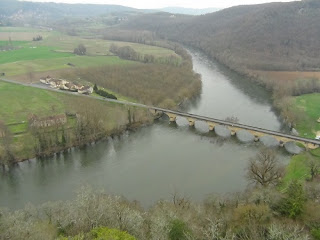 |
| The Chateau de Castelnaud |
Looking out from the ramparts, you can
see why this was such a strategic position. You can see the river and
valley below for miles.
 |
| No sneaking up on this castle |
In the Hundred Years War, the castle
changed hands between the French and the English six times. Not all
of those times involved battles. Sometimes a siege was enough
(accompanied by a bribe, of course) to convince the current occupant
to give up the castle for the other side.
But when a battle was involved, we saw
a ton of the implements used in said battle. Because the Chateau de
Castelnaud has huge displays of medieval weapons, siege weapons,
armor, and implements of the time.
At heart, I suppose, I am still just a
pre-teen boy who revels in the joy of looking at weapons and armor.
For that boy inside, this was a treat.
For armor, the displays began with
simple chain mail shirts or chain mail helms.
 |
| For the fashion conscious battle weary soldier |
But you could see plate mail as well.
Even a knight in plate mail on a horse covered in barding. (Barding
is the name for the armor plates that a horse wears.)
 |
| Look ma! I'm shiny! |
In the line of personal weaponry, well,
you can always start with the classics: swords and daggers. We
learned about the hilt and pommel, and how important the pommel is.
It keeps your hand from slipping off the end, and it is there to
counterbalance the weight of the blade.
 |
| It's kind of a double edged sword. Not just kind of. |
But if something more exotic is your
interest, what about flails, morning stars, or battle axes? How about
all three?
 |
| I do not want to get hit by any of these! |
Perhaps you are more of a war hammer
type. Did you realize that these don't look anything like Thor's
Mjolnir, but much more like really big versions of ball-peen hammers?
I didn't.
 |
| Hey guys, after the battle, let's go drive some rivets |
Have to face the cavalry? No problem.
You just need a staff weapon or a pole arm. These allow you to keep
your distance from the nasty charging knight while still dealing
maximum damage.
 |
| I wouldn't touch that with a ten foot pole. Unless it had something sharp at the end. |
Check out the many varied ends on these
pole arms. They could be used for all sorts of things. And we learned
that the inspiration for many of the shapes of the heads of the pole
arms came from the agricultural implements used in those days.
 |
| From the fields of wheat to the fields of battle |
And finally, what kind of defense could
a castle put up without the trusty crossbow? Of course, the challenge
with a crossbow is drawing back the string. In early forms, men just
had to pull. But then they invented the stirrup crossbow. You put
your foot in the stirrup and use the leverage of your whole body to
pull it back. But when even that isn't fast and easy enough, here
comes another improvement in crossbow technology: the crank! Not just
for fishing anymore! You can use it to draw back your bowstring.
 |
| Ready, aim, wait, wait, pull back the string, then aim. |
But personal weapons are only the
beginning of a battle at a castle. What you really need are siege
weapons and defense from those nasty crossbowmen on the castle walls
shooting down at you.
Well, you could certainly use the
monteau. This handy device lets you approach the castle with a huge
wooden shield in front of you. And it has holes in it for you to
shoot your own bows through.
 |
| A rolling wall. Genius! |
But even better is to stay far away
from the castle and blast them with varied catapults. Unfortunately
for the besieger, the besiegee may also have defensive catapults on
his walls. We saw a giant crossbow that was capable of launching a
bolt which could go through three men, a horse, and still have enough
thrust to lodge itself in a door. That's what it said! What a selling
point. Because most people besieging castles bring along their own
doors.
But the ultimate in siege weapon
technology was the trebuchet. First, engineers invented the mangonel,
much like the trebuchet. But the mangonel had a fixed counterweight.
The trebuchet has a hinged counterweight. Why is that better? You
still get all the launching power of the mangonel, but it is much
easier (though still not easy) to lift the counterweight and reset
the arm of the trebuchet for another shot. This brought the firing
rate from about one per hour to two per hour. Huge improvement!
 |
| Knock, knock. Who's there? |
The trebuchet was so effective in
breaking open castle walls that it continued to be used for another
150 to 200 years after the cannon was invented.
Yes, after we learned so much about
these weapons and armor, the kids were ready to sign up for the
service! A new swordsman and knight in the making.
 |
| Brave knights |
No comments:
Post a Comment